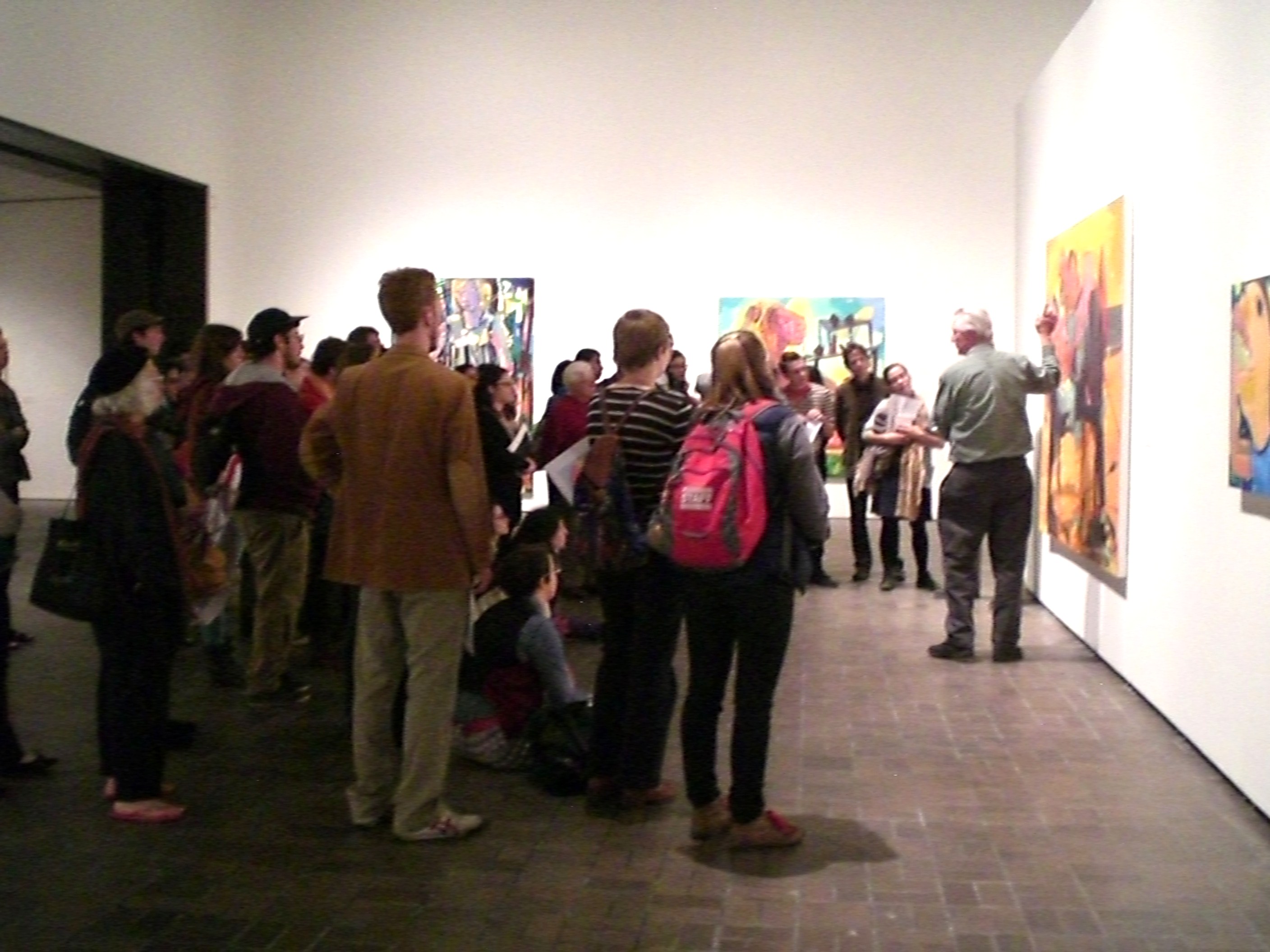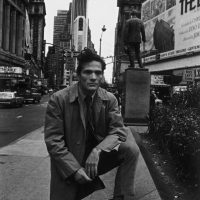Pier Paolo Pasolini: Subversive Prophet
Pier Paolo Pasolini (Italian, 1922–1975), one of 20th century Europe’s leading intellectuals, known for his prolific work as a poet, writer, and film director, and who railed against government corruption, materialism, consumerism, and political and social repression, will be the focus of Pier Paolo Pasolini: Subversive Prophet, an important exhibition showcasing the artist’s wide range of work and influence that will be on view at the Neuberger Museum of Art, Purchase College, SUNY, from February 12 through May 31, 2020.
A blunt and controversial figure, Pasolini often faced harsh rebuke. His unrelenting critiques of materialist values, the bourgeoisie and its institutions, and the destruction of Italy’s culture and traditions, were carried by media outlets, earning him an international reputation as a leading public intellectual. He championed the disinherited and viewed the intellectual as a savior of society.
“Outspoken and subversive, Pasolini made no concessions to anyone and often deliberately enraged those in power,” comments Patrice Giasson, Alex Gordon Curator of Art of the Americas. “Yet, Pasolini left three decades of amazing artistic production full of complex and rich themes that are as relevant today as they were then. The goal of this exhibition is to give American audiences the chance to discover his work. As of now, he is best known in intellectual and cinephile circles.”
Excellent examples of that output are contained in the Neuberger Museum’s two-part exhibition, which opens with an exploration of Pasolini’s reception in the Americas (Brazil, Argentina, Mexico and the United States). According to Paula Halperin, Purchase College Associate Professor of Latin American History and Chair, Film and Media Studies, Pasolini’s film work resonated as it addressed similar concerns of the Brazilian cinema of the 60s and 70s, “addressing themes of ‘center and periphery,’ the urban and the rural, [and] the First and the Third worlds, all unavoidable tropes in Latin American political cinema.” In the exhibition, homages to Pasolini by two Latin American artists: the Chilean, New York–based artist Alfredo Jaar, artist, architect, and filmmaker who loaned six works to the exhibition, including his short cinematic tribute to Pasolini; and the late Antonio Frasconi, whose artist’s book In Memoriam, Pier Paolo Pasolini: Una Disperata Vitalitá explores the artist’s tragic death. The book includes woodcut images and fragments of articles (1975) that carried news of Pasolini’s death.
In the 1960s, Pasolini twice visited the United States and met with countercultural and political activists, including university students and members of the Black Panther movement. He also sat for Richard Avedon, who created a series of portraits of Pasolini (Avedon was fascinated by countercultural figures like Pasolini, Jack Kerouac, and Allen Ginsberg). The artist was inspired and encouraged by his first visit to New York in 1966. In an interview with Oriana Fallaci, he declared: “In Europe, everything is finished. In America, one has the sense that everything is about to begin.” To the late Susan Sontag, American writer, filmmaker, philosopher, and political activist, Pasolini was “indisputably the most remarkable figure to have emerged in Italian arts and letters since the Second World War. Whatever he did once he did it had the quality of seeming necessary.” Also on view are a series of remarkable black and white images by Duilio Pallottelli, the photographer who accompanied Pasolini during his first trip to New York in 1966.
The second part of the exhibition is devoted to Pasolini’s powerful creativity and features his poetry, novels, paintings, drawings, and films. The artist’s drawings and sketches, several examples of which are reproduced for the exhibition, are precious testimonies of the people he admired. Giasson points out that Pasolini had a powerfully discerning eye. “He studied art history in Bologna and this really had an impact on his filming.” There are obvious references to Andrea Mantegna’s “Dead Christ” in Il Decameron, one of Pasolini’s 12 films, Piero della Francesca and other Renaissance painters in The Gospel According to Matthew (1964). “He imparted a fundamentally painterly sensibility to his films from the start: aiming as much to frame a new sense of the sacred as to assail form or upend convention.” (Ara H. Merjian, Art in America) Pasolini carefully chose the settings of his films and traveled the world over, not just to understand different cultures better, but to find the landscapes appropriate for the subject matter he covered. Eleven costumes for Pasolini’s theatrical ventures, designed in Rome by Danilo Donati for Farani, including the one used by Pasolini in The Canterbury Tales, also are showcased.
Pasolini’s voice was forged during the rise of Fascism and Communism in the 1930s, the war years, and post-war upheaval. Specifically, he addressed what he viewed as the universal homogenization of society, the dangers of capitalism and excessive consumption, the growing inequality between poor and rich, and hypocrisy and repression in social and political spheres. But with it all, Pasolini remained a poet. In an essay dedicated to the language of cinema, in which he recalls the importance of semiotics in the making of films, he concludes that, for him, “the language of cinema is fundamentally a ‘language of poetry.’
“To me, Pasolini was a subversive prophet, a civic poet, a barometer,” says Giasson. “He could talk about everything, including about the ways we behave, our sexuality, and our political inclinations. With Pasolini, nothing was off the table. He also understood and railed against the way Italy and the rest of the Western world were heading – into a uniform, universal, standardized society – even before the idea of globalization took hold. My hope is that through this exhibition, visitors will connect with the voice of a true humanist, who dedicated his life to making this world a better place in which to live.”
Pier Paolo Pasolini : Subversive Prophet is curated by Patrice Giasson, Alex Gordon Curator of Art of the Americas, with assistance provided by Elizabeth Orlandini, Curatorial intern; Greg Taylor, Purchase College Associate Provost for Academic Affairs; Paula Halperin, Purchase College Associate Professor of Latin American History and Chair, Film and Media Studies; Luigino Piccolo, Director at Sartoria Teatrale Farani; Mónica de la Mora Kuri, Art Coordinator Morelia Film Fest; and Courtney Lykins, Purchase College Art History student (’18). Generous support for this project is provided by the Alex Gordon Estate, the Friends of the Neuberger Museum of Art, and the Purchase College Foundation.
Programs Planned in Conjunction with the Exhibition:
Wednesday, February 12, 4:30-7 pm (snow date: February 19)
Spring Exhibition Opening Reception
Free with Museum admission. No registration required.
Enjoy an evening with friends from campus and the surrounding community while browsing the galleries filled with incredible works from each of the Spring 2020 exhibitions. Listen to live music; nibble on light refreshments; engage in conversation with artists, curators, and follow art lovers.
Thursday, February 27 | 2:30-3:30 pm
Queer Icons: Pasolini’s Perverse Religiosities
Part of the Neuberger’s Blueprint Event series.
Purchase professor Shaka McGlotten will be joined by panelists Brian Paccione and Johanna Markert will discuss issues raised by Pier Paolo Pasolini: Subversive Prophet. Pier Paolo Pasolini’s films are saturated with religious iconography shaped by his Catholic upbringing and the profound influence it had upon him. This iconography is refracted and distorted by the artist’s queerness. Saints and sinners abound and they are treated reverently even, or perhaps especially, when they are seductive or profane. Christianity for Pasolini is not the abstract promise of redemption nor the abject shame of sin; instead, it offers a rich archive to explore the ambivalence of belief and the limits of desire. Queer Icons: Pasolini’s Perverse Religiousities explores the intersection of the filmmaker’s homosexuality and his complex relationship to religiousity. The event will screen highlights from his films and will be followed by a roundtable with Shaka McGlotten, Brian Paccione, and Johanna Markert.
Friday, March 6 | 12:00-2:00 pm
Art Sandwiched-In: Pier Paolo Pasolini: Subversive Prophet
Free with Museum Admission; Members at all levels Free Join us for a guided tour of Pier Paolo Pasolini: Subversive Prophet with Patrice Giasson, Alex Gordon Curator of Art of the Americas
Free with Museum admission; free for Members at all levels
Art Sandwiched-In is a brown bag lunch-and-learn session that happens the first Friday of every month. Bring your own lunch and socialize with other art lovers from 12:30-1:00 pm in the Museum Snack Bar. The, join a curator for a tour of a current exhibition from 1:00–2:00 pm.
Wednesday, March 18 |3:30-4:30 pm
Pasolini and the Third World – Part of the Neuberger’s Blueprint Event series.
Purchase Film & Media Studies professor Paula Halperin will lead a faculty panel discussing current exhibition, Pier Paolo Pasolini: Subversive Prophet.
Pier Paolo Pasolini in New York 1966
Photographs by Duilio Pallottelli
- L’Europeo RCS/ph. Duilio Pallottelli

About Neuberger Museum of Art
Art at the Heart of Purchase College The Neuberger Museum of Art is Westchester County’s premier museum of modern, contemporary, and African art and an integral part of Purchase College, SUNY. From the mid-century American art and African art that form the core of the collection to the presentation of about ten changing exhibitions each year that range from retrospectives of the work of one artist to thematic surveys of contemporary art to newly-commissioned artist projects, we continue the commitment of founding patron Roy R. Neuberger (1903-2010) by championing the art of our time. A teaching museum, the Neuberger actively promotes cultural and educational opportunities for the community with special attention to reaching out to the culturally and ethnically diverse population of Westchester County and to targeting new audiences. OPEN: Wed-Sun, 12-5 pm Closed Mondays and major holidays
Initiated in 1974 with Roy R. Neuberger’s donation of 108 works of art, the permanent collection of the Neuberger Museum of Art has grown to over 6000 works of uncompromised quality and variety. Featuring prestigious examples of modern, contemporary and African art, holdings include the Roy R. Neuberger Collection of American Art, the Aimee W. Hirshberg and Lawrence Gussman Collections of African Art, the Hans Richter bequest of Dada and Surrealist objects, the George and Edith Rickey Collection of Constructivist art, and American, Mexican and European master works from the collection of the late Dina and Alexander Racolin. The Neuberger Museum of Art continues to collect and exhibit its permanent collection, enacting Mr. Neuberger’s commitment to supporting the work of contemporary artists who examine and expand the ideas of our day.


